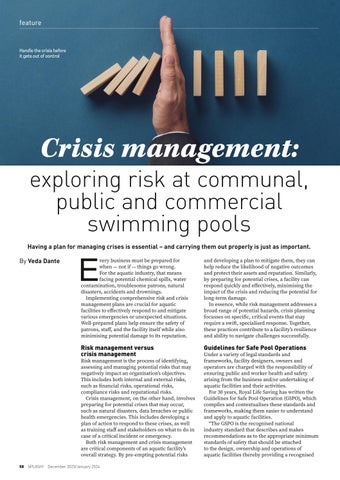feature
Handle the crisis before it gets out of control
Crisis management:
exploring risk at communal, public and commercial swimming pools Having a plan for managing crises is essential – and carrying them out properly is just as important. By Veda Dante
E
very business must be prepared for when — not if — things go wrong. For the aquatic industry, that means facing potential chemical spills, water contamination, troublesome patrons, natural disasters, accidents and drownings. Implementing comprehensive risk and crisis management plans are crucial for aquatic facilities to effectively respond to and mitigate various emergencies or unexpected situations. Well-prepared plans help ensure the safety of patrons, staff, and the facility itself while also minimising potential damage to its reputation.
and developing a plan to mitigate them, they can help reduce the likelihood of negative outcomes and protect their assets and reputation. Similarly, by preparing for potential crises, a facility can respond quickly and effectively, minimising the impact of the crisis and reducing the potential for long-term damage. In essence, while risk management addresses a broad range of potential hazards, crisis planning focusses on specific, critical events that may require a swift, specialised response. Together, these practices contribute to a facility’s resilience and ability to navigate challenges successfully.
Risk management versus crisis management
Guidelines for Safe Pool Operations
Risk management is the process of identifying, assessing and managing potential risks that may negatively impact an organisation’s objectives. This includes both internal and external risks, such as financial risks, operational risks, compliance risks and reputational risks. Crisis management, on the other hand, involves preparing for potential crises that may occur, such as natural disasters, data breaches or public health emergencies. This includes developing a plan of action to respond to these crises, as well as training staff and stakeholders on what to do in case of a critical incident or emergency. Both risk management and crisis management are critical components of an aquatic facility’s overall strategy. By pre-empting potential risks 58
SPLASH!
December 2023/January 2024
Under a variety of legal standards and frameworks, facility designers, owners and operators are charged with the responsibility of ensuring public and worker health and safety arising from the business and/or undertaking of aquatic facilities and their activities. For 30 years, Royal Life Saving has written the Guidelines for Safe Pool Operation (GSPO), which compiles and contextualises these standards and frameworks, making them easier to understand and apply to aquatic facilities. “The GSPO is the recognised national industry standard that describes and makes recommendations as to the appropriate minimum standards of safety that should be attached to the design, ownership and operations of aquatic facilities thereby providing a recognised
